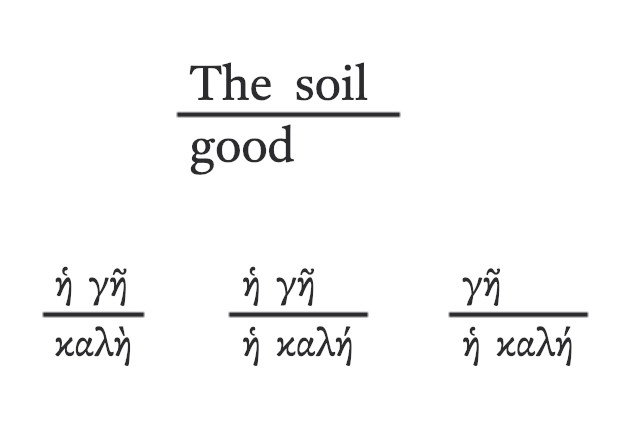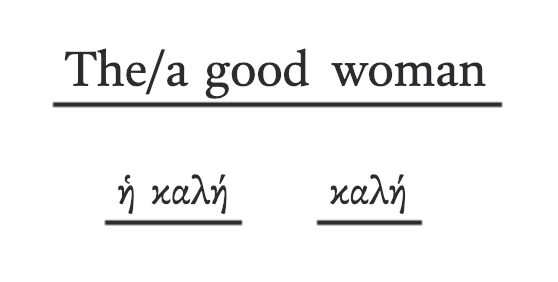Lesson 6 | Adjectives and Adverbs
Grammar Point 1: Adjectives
Adjectives are words that describe nouns, pronouns, and other adjectives.
In Koine Greek, adjectives change their form (decline) to match the word they are describing in case, gender, and number. You should be familiar with this from our lesson on the article. So, an adjective that modifies a nominative, masculine, singular word will also be nominative masculine singular. However, as you saw from this lesson’s new vocabulary, adjectives follow different noun patterns. It is important to realize that a Greek adjective will always match the word it describes in case, gender, and number but not necessarily in the noun pattern it follows. For example, in Matthew 13:37, we read: τὸ καλὸν σπέρμα. καλός is an adjective that follows the second noun pattern in the neuter, but σπέρμα is a third pattern noun. However, when we parse these words, they are both accusative (or nominative), neuter, singular. They look different because they follow different patterns, but καλὸν matches σπέρμα in gender, number, and case. So, we know that this adjective is describing this noun and can translate this phrase as “the good seed.”
Furthermore, Greek adjectives function in three ways, as:
- Attributive Adjectives
- Predicate Adjectives
- Substantival Adjectives
Let’s take a closer look at each of these functions.
Attributive Adjectives
These adjectives attribute or assign qualities to the words they describe. In English, we put this kind of adjective before the noun it describes (The poor man; The true story). However, in Greek, there are three unambiguous ways that an author could use an adjective in this way.
Always Attributive: The adjective is with the article
- ἡ καλὴ γῆ (Article + Adjective + Noun) = The good soil
- ἡ γῆ ἡ καλή (Article + Noun + Article + Adjective) = The good soil
- γῆ ἡ καλή (Noun + Article + Adjective) = The good soil
To diagram an attributive adjective, we put it directly under the word it describes.

Predicate Adjectives
These adjectives predicate or state something about the words they describe. In English, we need a being verb to use adjectives in this way (He is poor; Her story is true). In Greek, the being verb (εἰμί or γίνομαι) is optional. Instead, there are two unambiguous ways that an author could use an adjective in this way.
Always Predicate: The adjective is without the article but the noun is with it
- καλὴ ἡ γῆ (Adjective + Article + Noun) = The soil is good
- ἡ γῆ καλή (Article + Noun + Adjective) = The soil is good
To diagram a predicate adjective, we use a predicate construction with an implied being verb.

Attributive or Predicate?
Sometimes, we do not know if the adjective functions attributively or as a predicate. Only context will determine the adjective’s function in this construction (although we can rule out the substantival use).
- καλὴ γῆ = “a good soil” or “a soil is good.”
- γῆ καλὴ = “a good soil” or “a soil is good.”
Substantival Adjectives
These adjectives substitute or stand in for nouns. In English, we use the adjective with the definite article or we supply a noun with the adjective (The poor; the true one). In Greek, there are two ways an author could use adjectives in this way.
- ἡ καλή (Article + Adjective) = “the good” or “the good woman”
- καλή (Adjective) = “a good woman” or “a good one”
But for an adjective to function as a noun substitute, we need to make sure there are no other words that the adjective could be describing.
To diagram a substantival adjective, we place the adjective in whatever spot we would put it if it were a noun.

Summary
In summary, there are a few basic rules that you can rely on:
- Always Attributive: The adjective is with the article
- Always Predicate: The adjective is without the article but the noun is with it
- Always Substantival: The adjective is with the article and there is no other word the adjective could describe
- Attributive or Predicate: There is no article. Context decides.
The following quizlet will help you put these rules to the test. There are 20 cards. On one side, you will see an adjectival phrase in Greek. You must: (1) Parse each word, (2) Determine how the adjective is functioning, and (3) Translate into English. Once you have done this, flip the card over to see the correct answer.